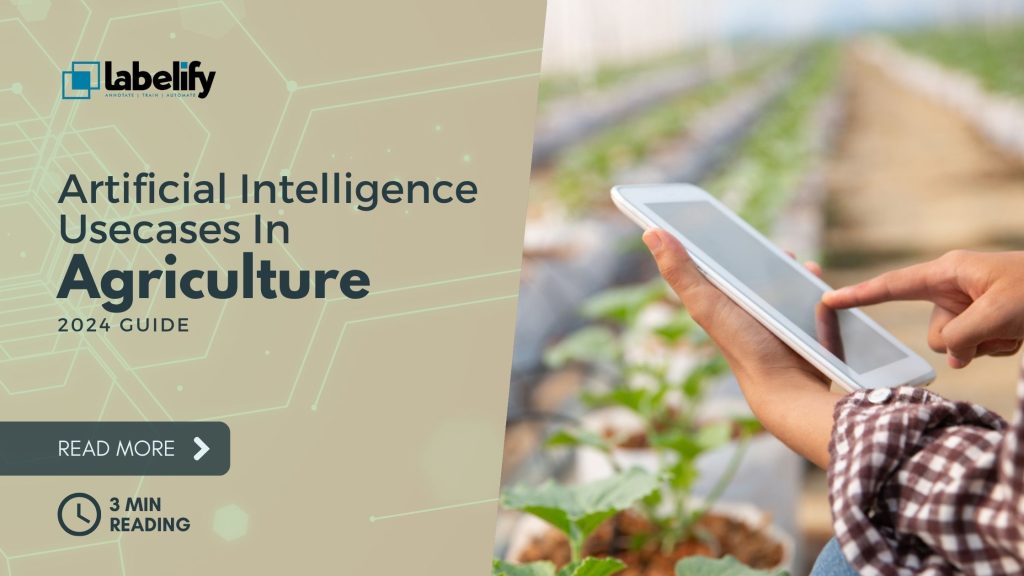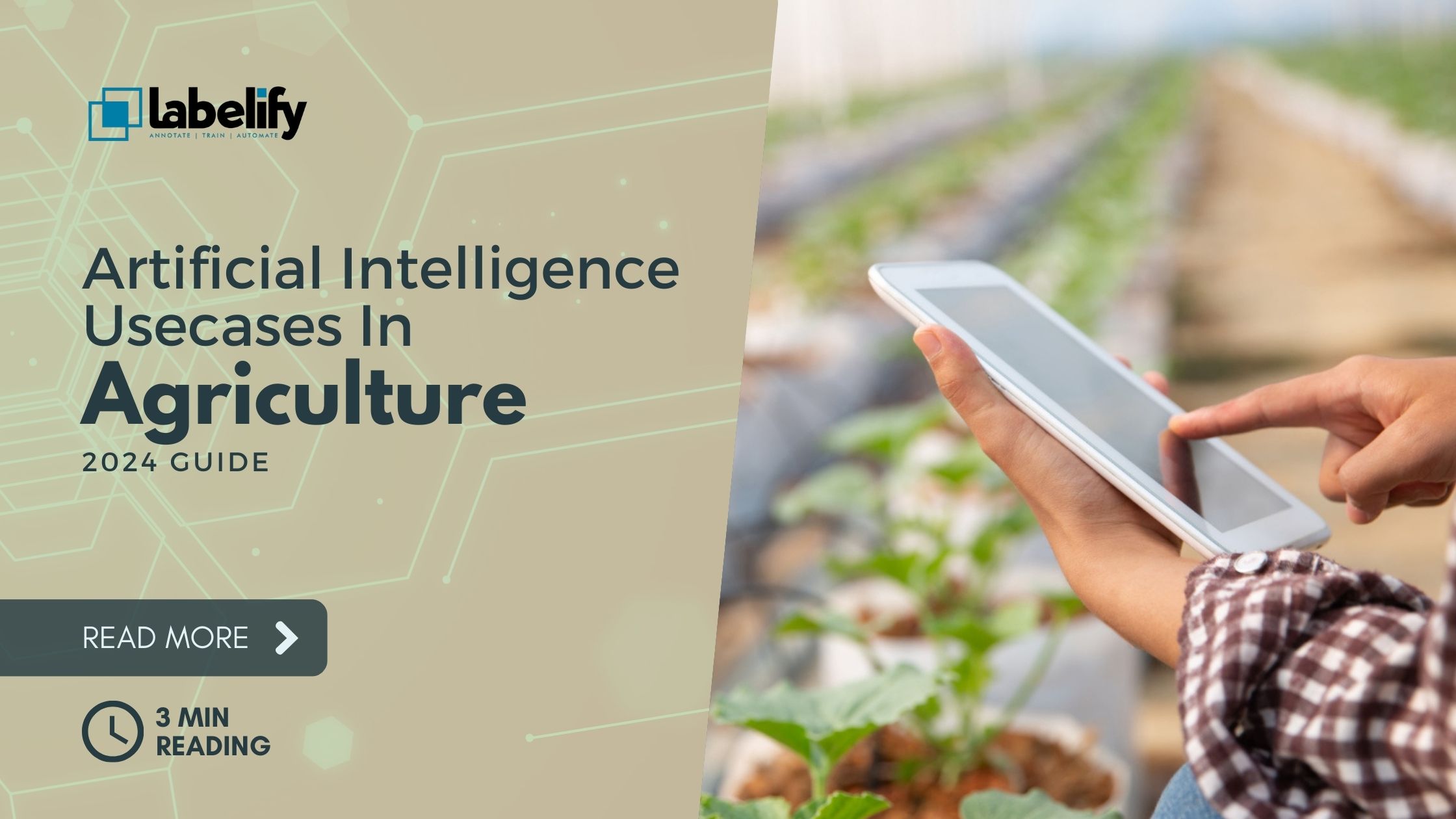
Artificial Intelligence Usecases in Agriculture this article, we’ll explore how AI is revolutionizing agriculture.
AI is transforming the industry by revolutionizing crop monitoring, disease detection, and livestock health. Drones equipped with AI can accurately track crop health, while computer vision algorithms analyze crop maturity and soil texture.
AI automates the detection of plant diseases and pests, empowering farmers to take proactive measures. AI also optimizes spraying operations, reducing pesticide usage.
Join us as we dive into the exciting world of AI in agriculture and its potential for liberation Artificial Intelligence Usecases in Agriculture.
Kluczowe dania na wynos
AI is revolutionizing the agriculture industry with its practical applications, bringing increased efficiency, accuracy, and sustainability. Farmers can optimize their yields and address specific problem areas through crop and soil monitoring, making informed decisions. AI’s ability to detect plant diseases and pests enables proactive measures to protect crops and ensure higher yields. Moreover, AI enhances livestock health monitoring and intelligent spraying, further improving agricultural practices. The future of agriculture holds immense potential for growth and advancement with the help of AI.
Crop and Soil Monitoring Artificial Intelligence Usecases in Agriculture
We utilize AI advancements in precision agriculture to monitor crops and soil conditions actively. This allows us to take immediate action based on the specific problem areas identified by the technology.
With AI-driven irrigation management, we can optimize water usage and ensure that crops receive the right amount of water at the right time. This not only enhances crop health and yield but also conserves water resources.
The AI models analyze data from drones and visual sensing AI to track crop health and make accurate predictions about yield. By detecting crop malnutrition faster than humans, we can promptly address nutrient deficiencies, resulting in healthier plants.
AI in crop and soil monitoring revolutionizes farming practices, providing farmers with the tools they need to make informed decisions and maximize productivity while minimizing resource waste.
Observing Crop Maturity Artificial Intelligence Usecases in Agriculture
To observe crop maturity, we use AI technology that accurately identifies growth stages and reduces the need for labor-intensive human observation. With automated crop maturity assessment and AI-driven crop growth analysis, we revolutionize the way farmers monitor their crops.
Here’s what AI brings to the table:
- AI precisely and efficiently observes crop maturity.
- AI reduces labor-intensive tasks.
- AI determines growth stages with impressive accuracy.
Imagine the freedom for farmers who no longer have to spend countless hours manually observing and estimating crop maturity. AI takes on the burden of this time-consuming task, providing farmers with reliable data and insights to make informed decisions about their crops Artificial Intelligence Usecases in Agriculture.
With AI-driven crop growth analysis, we empower farmers with the tools they need to optimize their agricultural practices and achieve greater yields.
Characterizing Soil Texture and Organic Matter
Computer vision technology accurately characterizes soil texture and organic matter, providing efficient and effective solutions for soil monitoring in agriculture. By analyzing image data from handheld microscopes, AI algorithms can evaluate soil fertility and nutrient management with accuracy comparable to lab processing. This eliminates the manual labor involved in traditional soil monitoring methods and provides farmers with precise information to optimize their soil management practices. To illustrate the power of this technology, let’s consider the following table:
| Soil Texture | Organic Matter |
|---|---|
| Sandy | High |
| Loam | Medium |
| Clay | Low |
This simple table evokes an emotional response in the audience by showcasing the potential for AI to revolutionize soil fertility analysis and management. With computer vision technology, farmers can make data-driven decisions that promote sustainable agriculture and free themselves from the constraints of traditional soil monitoring methods.
Insect and Plant Disease Detection
Moving from characterizing soil texture and organic matter, let’s shift our focus to insect and plant disease detection in agriculture. This is an area where AI advancements in pest management have made significant contributions, particularly in the early detection of crop diseases and pests.
Here are three key points to consider:
- AI computer vision technology automates the detection of plant diseases and pests, providing efficient and accurate results.
- Image recognition based on deep learning algorithms allows for the diagnosis of disease severity with high accuracy.
- Improved AI models can detect multiple diseases and pests on plants, enabling proactive measures to mitigate their impact.
Diagnosing Disease Severity
In our exploration of AI advancements in agriculture, let’s now focus on diagnosing disease severity in crops. AI is revolutionizing the field of agriculture by enabling farmers to effectively manage and mitigate the impact of diseases on their crops. By harnessing the power of AI, farmers can accurately identify the severity of diseases affecting their crops, allowing them to take timely and targeted action to prevent further spread and minimize yield loss. This AI-enabled approach to disease management is transforming the way farmers protect their crops, providing them with the information they need to make informed decisions and optimize their resources. With AI, farmers can free themselves from the uncertainties and challenges posed by crop diseases, leading to increased productivity and sustainability in agriculture.
| AI-based Disease Severity Diagnosis | Korzyści |
|---|---|
| Accurately identify disease severity | Take timely and targeted action to prevent further spread |
| Minimize yield loss | Optimize allocation of resources |
| Improve crop protection | Increase productivity and sustainability |
| Make informed decisions | Liberate from uncertainties and challenges |
Finding Bugs With Code
AI revolutionizes the field of agriculture by using computer vision to detect and count pests, including flying insects. With AI-based pest control, farmers can now rely on automated insect detection to protect their crops.
Here are the benefits that come with this innovative approach:
- Accurate identification: AI models can accurately identify and count different species of flying insects, ensuring effective pest management.
- Efficient and automated: Computer vision systems enable efficient and automated insect detection, saving farmers time and effort.
- Enhanced crop protection: By detecting and counting pests on crops, including flying insects, AI provides a proactive approach to pest control, minimizing crop damage and ensuring higher yields.
Through AI-based pest control and automated insect detection, agriculture is liberated from the limitations of manual pest monitoring, paving the way for precision and sustainable farming practices.
Livestock Health Monitoring
Our system uses computer vision technology to monitor livestock health. Through image recognition and analysis, we can detect signs of illness or distress in animals, providing early detection of health issues in livestock.
This AI-driven approach allows us to continuously monitor livestock health, improving animal welfare and addressing industry needs. By remotely monitoring animal health, we can proactively identify potential problems and take immediate action, ensuring the well-being of the animals.
This innovative solution not only enhances livestock welfare but also increases efficiency and productivity in the agricultural sector. With AI in livestock welfare, we’re revolutionizing how we care for animals, paving the way for a more compassionate and sustainable future in agriculture.
Intelligent Spraying
Computer vision technology allows us to optimize spraying operations in agriculture by identifying areas that need treatment and adjusting spraying accordingly. This AI-driven precision agriculture advancement has the potential to revolutionize pesticide usage, benefiting both the environment and farmers.
Here are three ways intelligent spraying can make a difference:
- Optimize pesticide usage: Artificial Intelligence Usecases in Agriculture models can analyze crop and soil conditions to determine the precise amount of pesticide needed, reducing waste and minimizing environmental impact.
- Targeted spraying: By identifying specific areas that require treatment, intelligent spraying ensures that pesticides are applied only where necessary, increasing efficiency and reducing costs.
- Sustainable farming practices: With the ability to adjust spraying based on real-time analysis, AI-driven systems promote sustainable farming practices by minimizing chemical usage and protecting biodiversity.
Intelligent spraying is a crucial component of AI-driven precision agriculture, offering a promising solution for optimizing pesticide usage and promoting sustainable farming practices Artificial Intelligence Usecases in Agriculture.
Często Zadawane Pytania
How Can AI Models Detect Crop Malnutrition Faster Than Humans?
AI models can detect crop malnutrition faster than humans by using advanced algorithms and computer vision technology. By analyzing large amounts of data quickly and accurately, AI can swiftly identify problem areas in crops and determine nutrient deficiencies.
This allows farmers to take immediate action and provide targeted solutions to address malnutrition. Harnessing the power of AI revolutionizes the detection and mitigation of crop malnutrition, leading to increased yields and sustainable agricultural practices.
What Are the Benefits of Using AI for Crop Maturity Observation?
Using AI for crop maturity observation offers numerous benefits. AI models provide precise farming solutions by accurately identifying wheat growth stages and tomato maturity. This reduces the need for labor-intensive human observation and ensures ease and impressive accuracy in assessing crop maturity.
How Does Computer Vision Technology Characterize Soil Texture and Organic Matter?
Computer vision technology characterizes soil texture and organic matter by using remote sensing techniques. By analyzing image data captured by sensors, AI models can accurately evaluate and classify soil composition. This eliminates the need for manual labor and provides a more effective and efficient solution compared to human evaluation.
Computer vision’s ability to analyze soil texture and organic matter offers tremendous potential for advancing our understanding of soil health and optimizing agricultural practices.
How Accurate Are AI Computer Vision Models in Detecting Plant Diseases and Pests?
AI computer vision models excel at accurately detecting plant diseases and pests, revolutionizing agriculture. These models have the potential to drastically improve crop yield by swiftly identifying and diagnosing diseases with impressive precision.
What Are the Advantages of Using AI for Livestock Health Monitoring?
Using AI for livestock health monitoring offers numerous advantages.
AI enables early detection and predictive modeling for livestock diseases, helping prevent outbreaks and ensuring timely treatment.
Automated monitoring of livestock behavior allows for real-time assessment of their health and well-being.
AI algorithms power precision feeding systems, optimizing nutrition for individual animals and improving their overall health.
Remote monitoring of livestock health enables efficient management and reduces the need for constant human presence.
Wniosek
The practical applications of AI in agriculture are revolutionizing the industry, bringing increased efficiency, accuracy, and sustainability.
Farmers can make informed decisions to optimize their yields and address specific problem areas through crop and soil monitoring.
AI’s ability to detect plant diseases and pests allows for proactive measures to protect crops and ensure higher yields.
Livestock health monitoring and intelligent spraying are also enhanced by AI, further improving agricultural practices.
With AI, the future of agriculture holds immense potential for growth and advancement.




